The Impact of Variable Ambient Temperatures on the Energy Efficiency and Performance of Electric Vehicles during Waste Collection
Abstract
1. Introduction and Background
2. Scientific Literature Review
2.1. Technical and Operational Parameters on Energy Efficiency and Performance of EV
| Research Parameter and Explanation | Year | Research Work | Research Description | Key Findings |
|---|---|---|---|---|
| Driving range—the distance an EV can travel on a single charge. | 2021 | Tran et al. [23] | Range extenders in BEV. | Review of various EV range-extending methods, including zinc-air batteries, internal combustion engines, fuel cells, micro gas turbines, and free-piston linear generators, with descriptions and operational principles. |
| 2020 | Xie et al. [24] | Data from experiments based on driving range analysis and vehicle energy flow. | Driving range and energy consumption are primarily determined by the average speed of the vehicle, its running time, and the frequency distribution of the braking process. | |
| 2021 | Miri et al. [25] | Range estimation based on power-based EV energy consumption model. | Creation of a precise computer-based model to calculate the energy consumption of an EV for a specific driving cycle. | |
| 2020 | Pevec et al. [26] | Driver’s range anxiety problem. | The range anxiety phenomenon, which is the fear that an electric vehicle (EV) won’t have the driving range to get to its intended destination due to its small battery size, frequently has a detrimental impact on driving behavior. | |
| Battery capacity—the amount of energy an EV can store. | 2020 | Dixon and Bell [27] | Effects on distribution networks of battery capacity, charger power, and availability for charging at various locations. | The parameters pertaining to battery capacity, charger power, and availability for charging at various locations have an impact on the ultimate charging need. |
| 2022 | Liu et al. [28] | Advanced batteries and emerging battery technologies. | Revision and evaluation, as well as opportunities and challenges of batteries and their management technologies, are revealed. | |
| 2021 | Zhang et al. [29] | Adaptive battery capacity estimation method. | Proposition of adaptive battery capacity estimation method based on incremental capacity analysis and data-driven techniques with experimental tests. | |
| 2021 | Thingvad et al. [30] | Battery lifespan and degradation. | Development of an extensive method for measuring the battery capacity of EVs series produced via the DC charge port. | |
| Charging time—duration required to replenish the EV’s battery to its full capacity. | 2020 | Kostopoulos et al. [31] | Energy losses that occur when the device is charging. | According to experimental research, the vehicle’s energy usage during charging is more than what the driver sees on the EV’s dashboard, and losses are nearly twice as high. |
| 2020 | Chen et al. [32] | Route selection equilibrium and charging wait time equilibrium. | A bi-level mathematical model is presented to determine the best distribution of charging stations based on capacity and the balance between route selection and charging wait time. | |
| 2020 | Brenna et al. [33] | Examination of EV charging methods using converter topologies. | Based on a careful examination, the ideal charging system size is calculated, as well as potential future trends. | |
| 2021 | Karakatič [34] | Genetic algorithm-based optimization of EVs routing’s nonlinear charging times. | A revolutionary two-layer genotype genetic algorithm is proposed to reduce driving times, the number of pauses at electric charging stations, and the amount of time needed for recharging. | |
| Power and torque—influence the EV’s acceleration, towing capacity, and overall performance | 2020 | Valladolid et al. [35] | Evaluation of an EV’s experimental performance using power and torque loss analysis. | Power curves for various systems include the results of the computed losses and the interpretation of the measurements; power losses are not associated with the state of charge (SOC). |
| 2022 | Torinsson et al. [36] | Minimizing power loss in EVs by allocating wheel torque. | The first technique involves minimizing power loss through wheel torque allocation based on quadratic programming optimization, while the second method involves an offline exhaustive search. | |
| Charging infrastructure—availability of charging infrastructure | 2021 | Hecht et al. [37] | EV charging station availability prediction with machine learning. | Machine learning algorithms based on historical charging station usage can be used to anticipate the occupied status of charging infrastructure. |
| 2021 | Falchetta and Noussan [38] | Accessibility and deployment trends of the European charging network. | An analysis of the European EV charging network (with maps) using algorithms, accessibility statistics, and crowdsourced information about charging stations. | |
| 2022 | Ahmad et al. [39] | An EV charging station’s location and how it affects the distribution network. | Techniques for optimizing the distribution network’s load impact and the location of EV charging stations. | |
| Strength and durability—related to the intensity of use, durability, and wear resistance. | 2021 | Vartanov [40] | High-strength steel for EVs. | The materials used to make the components for electric vehicles traditionally contain high-strength steel that was developed for cold stamping. |
| 2022 | Gupta et al. [41] | Polymers in EVs. | Comprehensive discussion comprising newer research areas for polymers in their use for EVs. | |
| Efficiency—longer ranges and lower energy consumption | 2020 | Albatayneh et al. [42] | Overall energy efficiency forEVs. | EVs supplied by natural gas power plants show the highest well-to-wheel (WTW) efficiency: 13–31%. The WTW efficiency is similar when supplied with coal-fired (13–27%) and diesel power plants (12–25%). |
| 2020 | Weiss et al. [43] | Energy efficiency trade-offs in EVs. | The weight-related efficiency trade-offs of EVs are large and can be exploited by stimulating a shift in driving modes. |
2.2. Factors Affecting the Operational Parameters of Electric Vehicles
3. Materials and Methods
- Going from city i to j stays on the edge,
- The choice of the next location on the ant agent’s route is determined by the probability, which depends on the distance between the current and the considered node and the amount of pheromone (a substance secreted by ants to mark the route) on the edge connecting both locations,
- Each town (location) can only be visited once per route.
4. Results
5. Discussion
6. Conclusions
Author Contributions
Funding
Data Availability Statement
Acknowledgments
Conflicts of Interest
Abbreviations
| ACO | Ant Colony Optimization |
| ARP | Arc Routing Problem |
| BEV | Battery Electric Vehicle |
| ECR | Energy Consumption Rate |
| EV | Electric Vehicle |
| GVW | Gross Vehicle Weight |
| HEV | Hybrid Electric Vehicle |
| ICEV | Internal Combustion Engine Vehicle |
| LCV | Light Commercial Vehicle |
| NMC | Nickel Manganese Cobalt |
| PEV | Plug-in Electric Vehicle |
| SOC | State Of Charge |
| TSP | Traveling Salesman Problem |
| VRP | Vehicle Routing Problem |
| WCRP | Waste Collection Routing Problem |
| ZE | Zero-Emission |
| ZE-HDV | Zero-Emission Heavy-Duty Vehicles |
References
- IEA. International Energy Agency. Global EV Outlook 2023: Catching Up with Climate Ambitions; Energy Agency: Paris, France, 2023; Available online: https://iea.blob.core.windows.net/assets/dacf14d2-eabc-498a-8263-9f97fd5dc327/GEVO2023.pdf (accessed on 12 January 2024).
- Hardman, S.; Chandan, A.; Tal, G.; Turrentine, T. The effectiveness of financial purchase incentives for battery electric vehicles—A review of the evidence. Renew. Sustain. Energy Rev. 2017, 80, 1100–1111. [Google Scholar] [CrossRef]
- Tu, J.-C.; Yang, C. Key Factors Influencing Consumers’ Purchase of Electric Vehicles. Sustainability 2019, 11, 3863. [Google Scholar] [CrossRef]
- Gnann, T.; Stephens, T.S.; Lin, Z.; Plötz, P.; Liu, C.; Brokate, J. What drives the market for plug-in electric vehicles?—A review of international PEV market diffusion models. Renew. Sustain. Energy Rev. 2018, 93, 158–164. [Google Scholar] [CrossRef]
- Zhou, Y.; Wang, M.; Hao, H.; Johnson, L.; Wang, H.; Hao, H. Plug-in electric vehicle market penetration and incentives: A global review. Mitig. Adapt. Strateg. Glob. Chang. 2015, 20, 777–795. [Google Scholar] [CrossRef]
- Wang, N.; Tang, L.; Pan, H. A global comparison and assessment of incentive policy on electric vehicle promotion. Sustain. Cities Soc. 2019, 44, 597–603. [Google Scholar] [CrossRef]
- Zhang, H.; Sheppard, C.J.; Lipman, T.E.; Zeng, T.; Moura, S.J. Charging infrastructure demands of shared-use autonomous electric vehicles in urban areas. Transp. Res. Part D Transp. Environ. 2020, 78, 102210. [Google Scholar] [CrossRef]
- Kabir, M.E.; Assi, C.; Alameddine, H.; Antoun, J.; Yan, J.; Antoun, M. Demand-Aware Provisioning of Electric Vehicles Fast Charging Infrastructure. IEEE Trans. Veh. Technol. 2020, 69, 6952–6963. [Google Scholar] [CrossRef]
- Gupta, R.S.; Tyagi, A.; Anand, S. Optimal allocation of electric vehicles charging infrastructure, policies and future trends. J. Energy Storage 2021, 43, 103291. [Google Scholar] [CrossRef]
- Yi, Z.; Liu, X.C.; Wei, R. Electric vehicle demand estimation and charging station allocation using urban informatics. Transp. Res. Part D Transp. Environ. 2022, 106, 103264. [Google Scholar] [CrossRef]
- Anastasiadou, K.; Gavanas, N.; Pitsiava-Latinopoulou, M.; Bekiaris, E. Infrastructure Planning for Autonomous Electric Vehicles, Integrating Safety and Sustainability Aspects: A Multi-Criteria Analysis Approach. Energies 2021, 14, 5269. [Google Scholar] [CrossRef]
- Sun, X.; Chen, Z.; Yin, Y. Integrated planning of static and dynamic charging infrastructure for electric vehicles. Transp. Res. Part D Transp. Environ. 2020, 83, 102331. [Google Scholar] [CrossRef]
- Danese, A.; Torsæter, B.N.; Sumper, A.; Garau, M. Planning of High-Power Charging Stations for Electric Vehicles: A Review. Appl. Sci. 2022, 12, 3214. [Google Scholar] [CrossRef]
- Deb, S.; Tammi, K.; Kalita, K.; Mahanta, P. Review of recent trends in charging infrastructure planning for electric vehicles. WIREs Energy Environ. 2018, 7, e306. [Google Scholar] [CrossRef]
- Hall, D.; Lutsey, N. Emerging Best Practices for Electric Vehicle Charging Infrastructure; The International Council on Clean Transportation (ICCT): Washington, DC, USA, 2017; p. 54. [Google Scholar]
- Mao, S.; Zhang, Y.; Bieker, G.; Rodriguez, F. Zero-Emission Bus and Truck Market in China: A 2021 Update. Working Paper International Council on Clean Transportation, 4. 2023. Available online: https://theicct.org/wp-content/uploads/2023/01/china-hvs-ze-bus-truck-market-2021-jan23.pdf (accessed on 28 January 2024).
- Shen, C.; Mao, S. Zero-Emission Bus and Truck Market in China: A 2022 Update. Working Paper International Council on Clean Transportation, 31. 2023. Available online: https://theicct.org/wp-content/uploads/2023/12/ID-57-%E2%80%93-ZETs-China_Final.pdf (accessed on 28 January 2024).
- Nowakowski, P.; Wala, M. The evaluation of energy consumption in transportation and processing of municipal waste for recovery in a waste-to-energy plant: A case study of Poland. Environ. Sci. Pollut. Res. 2023, 30, 8809–8821. [Google Scholar] [CrossRef]
- Ewert, R.; Grahle, A.; Martins-Turner, K.; Syré, A.; Nagel, K.; Göhlich, D. Electrification of Urban Waste Collection: Introducing a Simulation-Based Methodology for Feasibility, Impact and Cost Analysis; Technische Universität Berlin: Berlin, Germany, 2020. [Google Scholar]
- Demartini, M.; Ferrari, M.; Govindan, K.; Tonelli, F. The transition to electric vehicles and a net zero economy: A model based on circular economy, stakeholder theory, and system thinking approach. J. Clean. Prod. 2023, 410, 137031. [Google Scholar] [CrossRef]
- Dik, A.; Kutlu, C.; Sun, H.; Calautit, J.K.; Boukhanouf, R.; Omer, S. Towards sustainable urban living: A holistic energy strategy for electric vehicle and heat pump adoption in residential communities. Sustain. Cities Soc. 2024, 107, 105412. [Google Scholar] [CrossRef]
- Kurniawan, T.A.; Othman, M.H.D.; Liang, X.; Goh, H.H.; Gikas, P.; Kusworo, T.D.; Anouzla, A.; Chew, K.W. Decarbonization in waste recycling industry using digitalization to promote net-zero emissions and its implications on sustainability. J. Environ. Manag. 2023, 338, 117765. [Google Scholar] [CrossRef]
- Tran, M.-K.; Bhatti, A.; Vrolyk, R.; Wong, D.; Panchal, S.; Fowler, M.; Fraser, R. A Review of Range Extenders in Battery Electric Vehicles: Current Progress and Future Perspectives. World Electr. Veh. J. 2021, 12, 54. [Google Scholar] [CrossRef]
- Xie, Y.; Li, Y.; Zhao, Z.; Dong, H.; Wang, S.; Liu, J.; Guan, J.; Duan, X. Microsimulation of electric vehicle energy consumption and driving range. Appl. Energy 2020, 267, 115081. [Google Scholar] [CrossRef]
- Miri, I.; Fotouhi, A.; Ewin, N. Electric vehicle energy consumption modelling and estimation—A case study. Int. J. Energy Res. 2021, 45, 501–520. [Google Scholar] [CrossRef]
- Pevec, D.; Babic, J.; Carvalho, A.; Ghiassi-Farrokhfal, Y.; Ketter, W.; Podobnik, V. A survey-based assessment of how existing and potential electric vehicle owners perceive range anxiety. J. Clean. Prod. 2020, 276, 122779. [Google Scholar] [CrossRef]
- Dixon, J.; Bell, K. Electric vehicles: Battery capacity, charger power, access to charging and the impacts on distribution networks. eTransportation 2020, 4, 100059. [Google Scholar] [CrossRef]
- Liu, W.; Placke, T.; Chau, K. Overview of batteries and battery management for electric vehicles. Energy Rep. 2022, 8, 4058–4084. [Google Scholar] [CrossRef]
- Zhang, C.; Kang, Y.; Duan, B.; Zhou, Z.; Zhang, Q.; Shang, Y.; Chen, A. An Adaptive Battery Capacity Estimation Method Suitable for Random Charging Voltage Range in Electric Vehicles. IEEE Trans. Ind. Electron. 2021, 69, 9121–9132. [Google Scholar] [CrossRef]
- Thingvad, A.; Calearo, L.; Andersen, P.B.; Marinelli, M. Empirical Capacity Measurements of Electric Vehicles Subject to Battery Degradation From V2G Services. IEEE Trans. Veh. Technol. 2021, 70, 7547–7557. [Google Scholar] [CrossRef]
- Kostopoulos, E.D.; Spyropoulos, G.C.; Kaldellis, J.K. Real-world study for the optimal charging of electric vehicles. Energy Rep. 2020, 6, 418–426. [Google Scholar] [CrossRef]
- Chen, R.; Qian, X.; Miao, L.; Ukkusuri, S.V. Optimal charging facility location and capacity for electric vehicles considering route choice and charging time equilibrium. Comput. Oper. Res. 2020, 113, 104776. [Google Scholar] [CrossRef]
- Brenna, M.; Foiadelli, F.; Leone, C.; Longo, M. Electric vehicles charging technology review and optimal size estimation. J. Electr. Eng. Technol. 2020, 15, 2539–2552. [Google Scholar] [CrossRef]
- Karakatič, S. Optimizing nonlinear charging times of electric vehicle routing with genetic algorithm. Expert Syst. Appl. 2021, 164, 114039. [Google Scholar] [CrossRef]
- Valladolid, J.D.; Albarado, R.; Mallahuari, D.; Patino, D. Experimental Performance Evaluation of Electric Vehicles (EV) Based on Analysis of Power and Torque Losses. In Proceedings of the 2020 IEEE International Conference on Industrial Technology (ICIT), Buenos Aires, Argentina, 26–28 February 2020; pp. 933–938. [Google Scholar]
- Torinsson, J.; Jonasson, M.; Yang, D.; Jacobson, B. Energy reduction by power loss minimisation through wheel torque allocation in electric vehicles: A simulation-based approach. Veh. Syst. Dyn. 2022, 60, 1488–1511. [Google Scholar] [CrossRef]
- Hecht, C.; Figgener, J.; Sauer, D.U. Predicting Electric Vehicle Charging Station Availability Using Ensemble Machine Learning. Energies 2021, 14, 7834. [Google Scholar] [CrossRef]
- Falchetta, G.; Noussan, M. Electric vehicle charging network in Europe: An accessibility and deployment trends analysis. Transp. Res. Part D Transp. Environ. 2021, 94, 102813. [Google Scholar] [CrossRef]
- Ahmad, F.; Iqbal, A.; Ashraf, I.; Marzband, M.; Khan, I. Optimal location of electric vehicle charging station and its impact on distribution network: A review. Energy Rep. 2022, 8, 2314–2333. [Google Scholar] [CrossRef]
- Vartanov, G. High-Strength Steel for Electric Vehicles. Am&p Tech. Artic. 2021, 179, 24–27. [Google Scholar] [CrossRef]
- Gupta, P.; Toksha, B.; Patel, B.; Rushiya, Y.; Das, P.; Rahaman, M. Recent Developments and Research Avenues for Polymers in Electric Vehicles. Chem. Rec. 2022, 22, e202200186. [Google Scholar] [CrossRef]
- Albatayneh, A.; Assaf, M.N.; Alterman, D.; Jaradat, M. Comparison of the Overall Energy Efficiency for Internal Combustion Engine Vehicles and Electric Vehicles. Sci. J. Riga Tech. Univ. Environ. Clim. Technol. 2020, 24, 669–680. [Google Scholar] [CrossRef]
- Weiss, M.; Cloos, K.C.; Helmers, E. Energy efficiency trade-offs in small to large electric vehicles. Environ. Sci. Eur. 2020, 32, 46. [Google Scholar] [CrossRef]
- Hu, C.; Jain, G.; Schmidt, C.; Strief, C.; Sullivan, M. Online estimation of lithium-ion battery capacity using sparse Bayesian learning. J. Power Sources 2015, 289, 105–113. [Google Scholar] [CrossRef]
- Farmann, A.; Waag, W.; Marongiu, A.; Sauer, D.U. Critical review of on-board capacity estimation techniques for lithium-ion batteries in electric and hybrid electric vehicles. J. Power Sources 2015, 281, 114–130. [Google Scholar] [CrossRef]
- You, G.-W.; Park, S.; Oh, D. Real-time state-of-health estimation for electric vehicle batteries: A data-driven approach. Appl. Energy 2016, 176, 92–103. [Google Scholar] [CrossRef]
- Ozkurt, C.; Camci, F.; Atamuradov, V.; Odorry, C. Integration of sampling based battery state of health estimation method in electric vehicles. Appl. Energy 2016, 175, 356–367. [Google Scholar] [CrossRef]
- Slattery, M.; Dunn, J.; Kendall, A. Charting the electric vehicle battery reuse and recycling network in North America. Waste Manag. 2024, 174, 76–87. [Google Scholar] [CrossRef] [PubMed]
- Qiu, C.; Wang, G. New evaluation methodology of regenerative braking contribution to energy efficiency improvement of electric vehicles. Energy Convers. Manag. 2016, 119, 389–398. [Google Scholar] [CrossRef]
- Li, L.; Li, X.; Wang, X.; Song, J.; He, K.; Li, C. Analysis of downshift’s improvement to energy efficiency of an electric vehicle during regenerative braking. Appl. Energy 2016, 176, 125–137. [Google Scholar] [CrossRef]
- Yang, C.; Sun, T.; Wang, W.; Li, Y.; Zhang, Y.; Zha, M. Regenerative braking system development and perspectives for electric vehicles: An overview. Renew. Sustain. Energy Rev. 2024, 198, 114389. [Google Scholar] [CrossRef]
- Liu, K.; Wang, J.; Yamamoto, T.; Morikawa, T. Modelling the multilevel structure and mixed effects of the factors influencing the energy consumption of electric vehicles. Appl. Energy 2016, 183, 1351–1360. [Google Scholar] [CrossRef]
- Ahn, K.; Rakha, H.; Trani, A.; Van Aerde, M. Estimating vehicle fuel consumption and emissions based on instantaneous speed and acceleration levels. J. Transp. Eng. 2002, 128, 182–190. [Google Scholar] [CrossRef]
- Hu, K.; Wu, J.; Liu, M. Exploring the Energy Efficiency of Electric Vehicles with Driving Behavioral Data from a Field Test and Questionnaire. J. Adv. Transp. 2018, 2018, 1074817. [Google Scholar] [CrossRef]
- Iwan, S.; Nürnberg, M.; Jedliński, M.; Kijewska, K. Efficiency of light electric vehicles in last mile deliveries—Szczecin case study. Sustain. Cities Soc. 2021, 74, 103167. [Google Scholar] [CrossRef]
- Berjoza, D.; Jurgena, I. Effects of change in the weight of electric vehicles on their performance characteristics. Agron. Res. 2017, 15, 952–963. [Google Scholar]
- Travesset-Baro, O.; Rosas-Casals, M.; Jover, E. Transport energy consumption in mountainous roads. A comparative case study for internal combustion engines and electric vehicles in Andorra. Transp. Res. Part D Transp. Environ. 2015, 34, 16–26. [Google Scholar] [CrossRef]
- Liu, K.; Yamamoto, T.; Morikawa, T. Impact of road gradient on energy consumption of electric vehicles. Transp. Res. Part D Transp. Environ. 2017, 54, 74–81. [Google Scholar] [CrossRef]
- Jonas, T.; Hunter, C.D.; Macht, G.A. Quantifying the Impact of Traffic on Electric Vehicle Efficiency. World Electr. Veh. J. 2022, 13, 15. [Google Scholar] [CrossRef]
- Fetene, G.M.; Kaplan, S.; Mabit, S.L.; Jensen, A.F.; Prato, C.G. Harnessing big data for estimating the energy consumption and driving range of electric vehicles. Transp. Res. Part D Transp. Environ. 2017, 54, 1–11. [Google Scholar] [CrossRef]
- Hamwi, H.; Alasseri, R.; Aldei, S.; Al-Kandari, M. A Pilot Study of Electrical Vehicle Performance, Efficiency, and Limitation in Kuwait’s Harsh Weather and Environment. Energies 2022, 15, 7466. [Google Scholar] [CrossRef]
- Yuksel, T.; Michalek, J.J. Effects of Regional Temperature on Electric Vehicle Efficiency, Range, and Emissions in the United States. Environ. Sci. Technol. 2015, 49, 3974–3980. [Google Scholar] [CrossRef]
- Wilber, M.; Whitney, E.; Leach, T.; Haupert, C.; Pike, C. Cold Weather Issues for Electric Vehicles (EVs) in Alaska; Alaska Center for Energy & Power: Anchorage, AK, USA, 2021; Available online: https://www.uaf.edu/acep/files/projects/Cold-Weather-Issues-for-EVs-in-Alaska.pdf (accessed on 12 March 2024).
- Jeffers, M.A.; Chaney, L.; Rugh, J.P. Climate Control Load Reduction Strategies for Electric Drive Vehicles in Warm Weather; SAE Technical Paper; National Renewable Energy Lab. (NREL): Golden, CO, USA, 2015. [Google Scholar] [CrossRef]
- Ma, S.; Jiang, M.; Tao, P.; Song, C.; Wu, J.; Wang, J.; Deng, T.; Shang, W. Temperature effect and thermal impact in lithium-ion batteries: A review. Prog. Nat. Sci. 2018, 28, 653–666. [Google Scholar] [CrossRef]
- Hajidavalloo, M.R.; Chen, J.; Hu, Q.; Song, Z.; Yin, X.; Li, Z. NMPC-Based Integrated Thermal Management of Battery and Cabin for Electric Vehicles in Cold Weather Conditions. IEEE Trans. Intell. Veh. 2023, 8, 4208–4222. [Google Scholar] [CrossRef]
- Smith, R.; Morison, M.; Capelle, D.; Christie, C.; Blair, D. GPS-based optimization of plug-in hybrid electric vehicles’ power demands in a cold weather city. Transp. Res. Part D Transp. Environ. 2011, 16, 614–618. [Google Scholar] [CrossRef]
- Aris, A.M.; Shabani, B. An Experimental Study of a Lithium Ion Cell Operation at Low Temperature Conditions. Energy Procedia 2017, 110, 128–135. [Google Scholar] [CrossRef]
- Lindgren, J.; Lund, P.D. Effect of extreme temperatures on battery charging and performance of electric vehicles. J. Power Sources 2016, 328, 37–45. [Google Scholar] [CrossRef]
- Kambly, K.; Bradley, T.H. Geographical and temporal differences in electric vehicle range due to cabin conditioning energy consumption. J. Power Sources 2015, 275, 468–475. [Google Scholar] [CrossRef]
- Zhang, Z.; Li, W.; Zhang, C.; Chen, J. Climate control loads prediction of electric vehicles. Appl. Therm. Eng. 2017, 110, 1183–1188. [Google Scholar] [CrossRef]
- Wager, G.; Whale, J.; Braunl, T. Driving electric vehicles at highway speeds: The effect of higher driving speeds on energy consumption and driving range for electric vehicles in Australia. Renew. Sustain. Energy Rev. 2016, 63, 158–165. [Google Scholar] [CrossRef]
- Vaz, W.; Nandi, A.K.; Landers, R.G.; Koylu, U.O. Electric vehicle range prediction for constant speed trip using multi-objective optimization. J. Power Sources 2015, 275, 435–446. [Google Scholar] [CrossRef]
- Andreev, A.; Vozmilov, A.; Kalmakov, V. Simulation of Lithium Battery Operation Under Severe Temperature Conditions. Procedia Eng. 2015, 129, 201–206. [Google Scholar] [CrossRef]
- Bramel, J.; Simchi-Levi, D. A Location Based Heuristic for General Routing Problems. Oper. Res. 1995, 43, 649–660. [Google Scholar] [CrossRef]
- Ralphs, T.K.; Kopman, L.; Pulleyblank, W.R.; Trotter, L.E. On the capacitated vehicle routing problem. Math. Program. 2003, 94, 343–359. [Google Scholar] [CrossRef]
- Ulusoy, G. The fleet size and mix problem for capacitated arc routing. Eur. J. Oper. Res. 1985, 22, 329–337. [Google Scholar] [CrossRef]
- Liang, Y.C.; Minanda, V.; Gunawan, A. Waste collection routing problem: A mini-review of recent heuristic approaches and applications. Waste Manag. Res. 2022, 40, 519–537. [Google Scholar] [CrossRef]
- Toth, P.; Vigo, D. (Eds.) Vehicle Routing: Problems, Methods, and Applications; Society for Industrial and Applied Mathematics: Philadelphia, PA, USA, 2014. [Google Scholar]
- Nowakowski, P.; Szwarc, K.; Boryczka, U. Vehicle route planning in e-waste mobile collection on demand supported by artificial intelligence algorithms. Transp. Res. Part D Transp. Environ. 2018, 63, 1–22. [Google Scholar] [CrossRef]
- Nowakowski, P.; Szwarc, K.; Wala, M. Investigation of the sustainable waste transportation in urban and rural municipalities—Key environmental parameters of the collection vehicles use. In Circular Economy and Sustainability; Elsevier: Amsterdam, The Netherlands, 2022; pp. 457–487. [Google Scholar]
- Cieśla, M.; Mrówczyńska, B. Problem of medicines distribution on the example of pharmaceutical wholesale. In Graph-Based Modelling in Engineering; Springer: Cham, Switzerland, 2017; pp. 51–65. [Google Scholar]
- Escario, J.B.; Jimenez, J.F.; Giron-Sierra, J.M. Ant Colony Extended: Experiments on the Travelling Salesman Problem. Expert Syst. Appl. 2015, 42, 390–410. [Google Scholar] [CrossRef]
- Huang, S.H.; Lin, P.C. Vehicle routing–scheduling for municipal waste collection system under the “Keep Trash off the Ground” policy. Omega 2015, 55, 24–37. [Google Scholar] [CrossRef]
- Karadimas, N.V.; Papatzelou, K.; Loumos, V.G. Optimal solid waste collection routes identified by the ant colony system algorithm. Waste Manag. Res. J. Sustain. Circ. Econ. 2007, 25, 139–147. [Google Scholar] [CrossRef] [PubMed]
- Liu, J.; He, Y. A Clustering-Based Multiple Ant Colony System for the Waste Collection Vehicle Routing Problems. In Proceedings of the 2012 5th International Symposium on Computational Intelligence and Design (ISCID), Hangzhou, China, 28–29 October 2012; pp. 182–185. [Google Scholar]
- Seçkiner, S.U.; Shumye, A.; Geçer, S. Minimizing Solid Waste Collection Routes Using Ant Colony Algorithm: A Case Study in Gaziantep District. J. Transp. Logist. 2021, 6, 29–47. [Google Scholar] [CrossRef]
- Dorigo, M. Ant Colony Optimization—New Optimization Techniques in Engineering; Onwubolu, G.C., BV Babu, B.V., Eds.; Springer: Berlin/Heidelberg, Germany, 1991; pp. 101–117. [Google Scholar]
- Dorigo, M.; Socha, K. An introduction to ant colony optimization. In Handbook of Approximation Algorithms and Metaheuristics; Chapman and Hall/CRC: Boca Raton, FL, USA, 2018; pp. 395–408. [Google Scholar]
- Nowakowski, P.; Szwarc, K.; Boryczka, U. Combining an artificial intelligence algorithm and a novel vehicle for sustainable e-waste collection. Sci. Total. Environ. 2020, 730, 138726. [Google Scholar] [CrossRef]
- Nowakowski, P.; Wala, M. Electric waste collection vehicles in Poland: A challenge or burden for local communities? Sustain. Chem. Pharm. 2024, 38, 101452. [Google Scholar] [CrossRef]
- Al-Wreikat, Y.; Serrano, C.; Sodré, J.R. Effects of ambient temperature and trip characteristics on the energy consumption of an electric vehicle. Energy 2022, 238, 122028. [Google Scholar] [CrossRef]
- Sun, X.; Zhou, F.; Fu, J.; Liu, J. Experiment and simulation study on energy flow characteristics of a battery electric vehicle throughout the entire driving range in low-temperature conditions. Energy 2024, 292, 130542. [Google Scholar] [CrossRef]
- Kirkaldy, N.; Samieian, M.A.; Offer, G.J.; Marinescu, M.; Patel, Y. Lithium-ion battery degradation: Comprehensive cycle ageing data and analysis for commercial 21700 cells. J. Power Sources 2024, 603, 234185. [Google Scholar] [CrossRef]
- Bernagozzi, M.; Georgoulas, A.; Miché, N.; Marengo, M. Novel Loop Heat Pipe System for EV Thermal Management of Batteries: Effects of Ambient Temperatures. Transp. Res. Procedia 2023, 70, 162–169. [Google Scholar] [CrossRef]
- Babu, A.R.; Minovski, B.; Sebben, S. Thermal encapsulation of large battery packs for electric vehicles operating in cold climate. Appl. Therm. Eng. 2022, 212, 118548. [Google Scholar] [CrossRef]
- Lee, G.; Song, J.; Lim, Y.; Park, S. Energy consumption evaluation of passenger electric vehicle based on ambient temperature under Real-World driving conditions. Energy Convers. Manag. 2024, 306, 118289. [Google Scholar] [CrossRef]

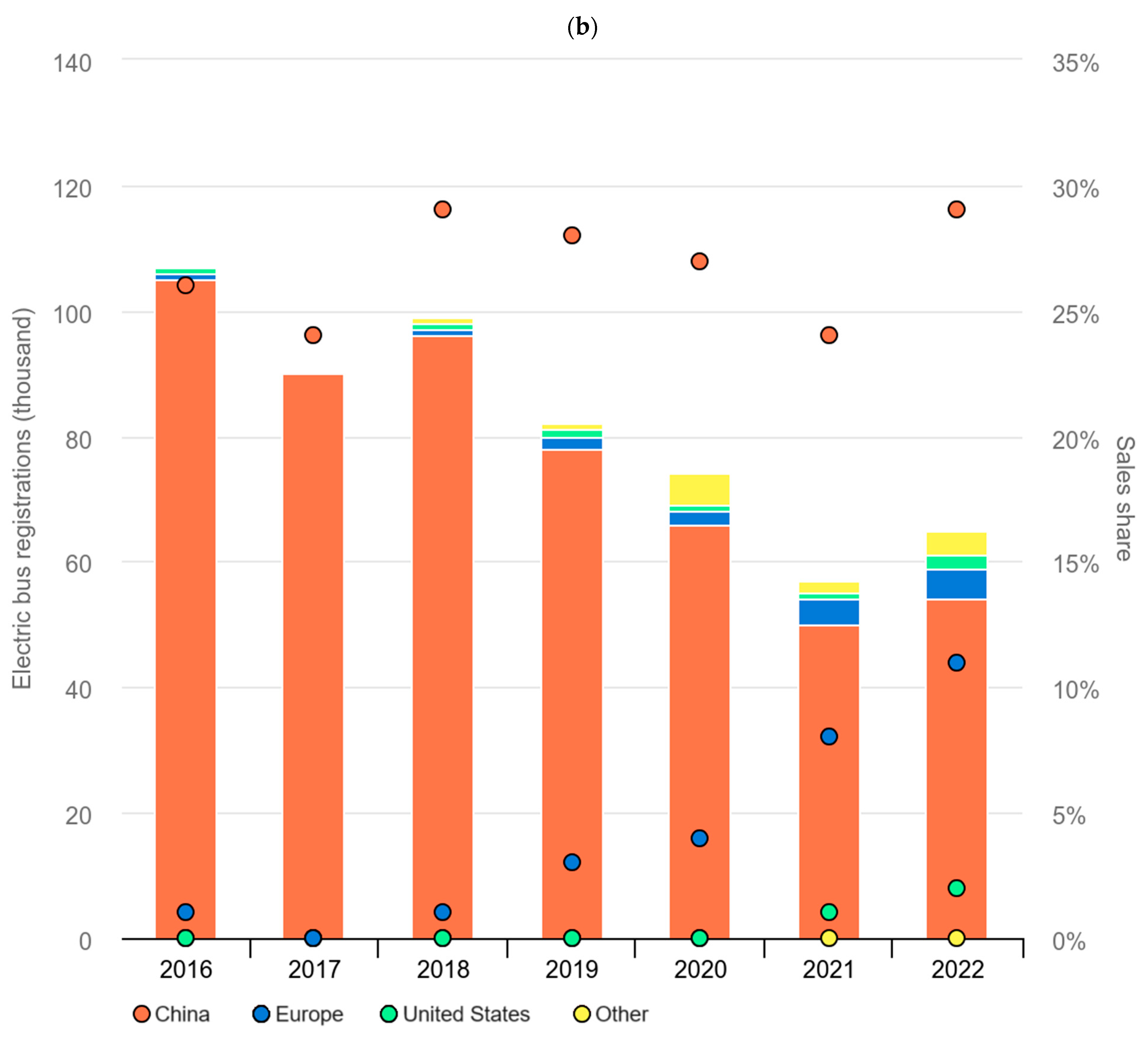


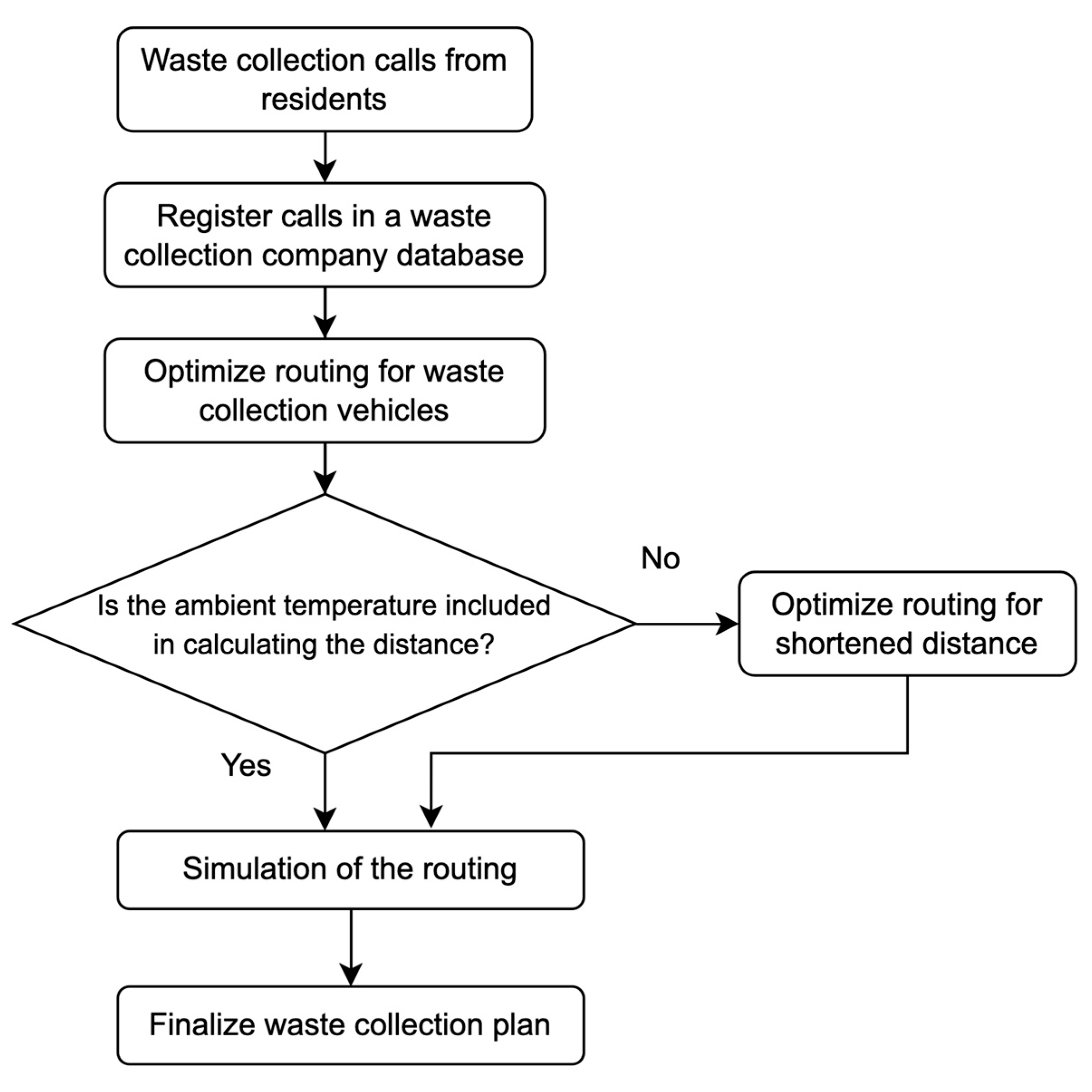

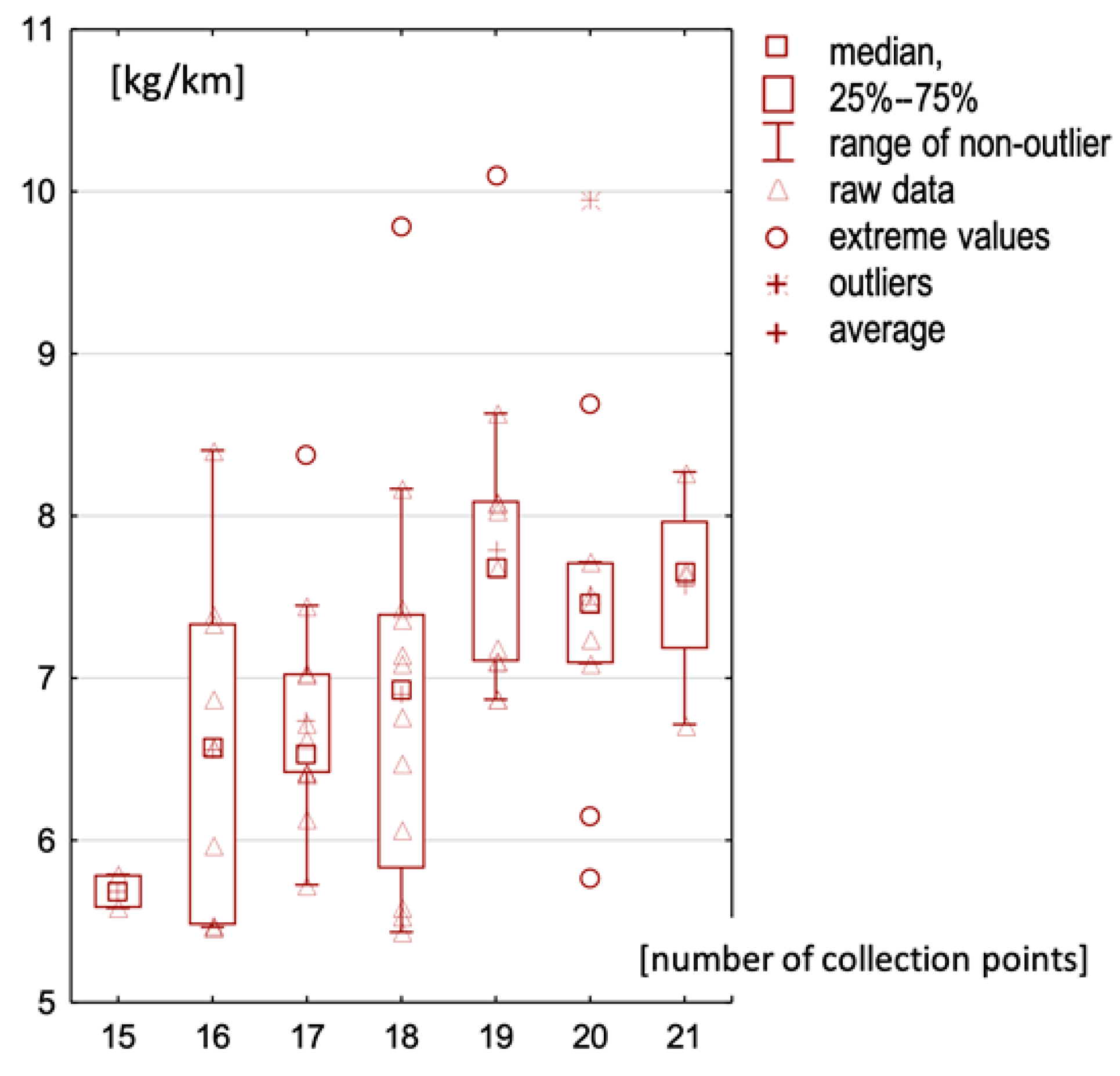
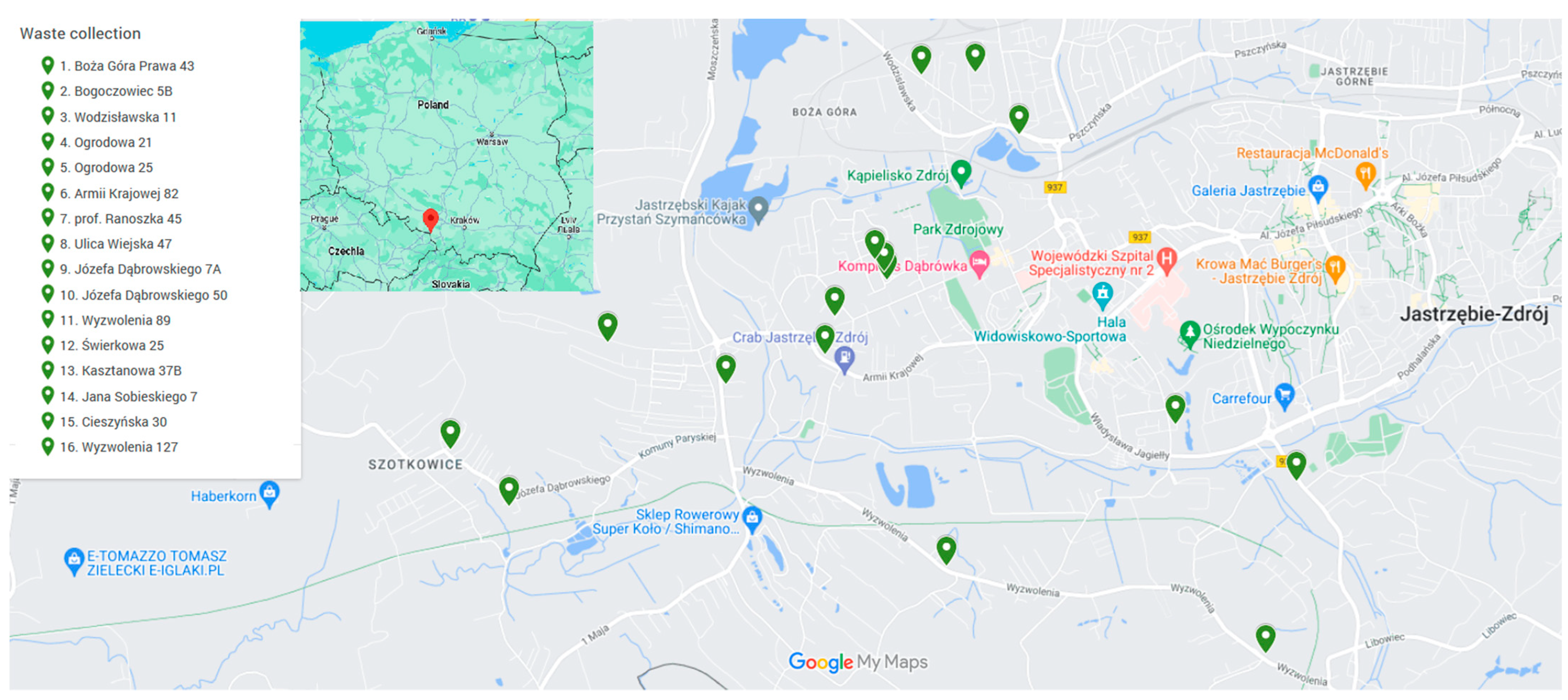
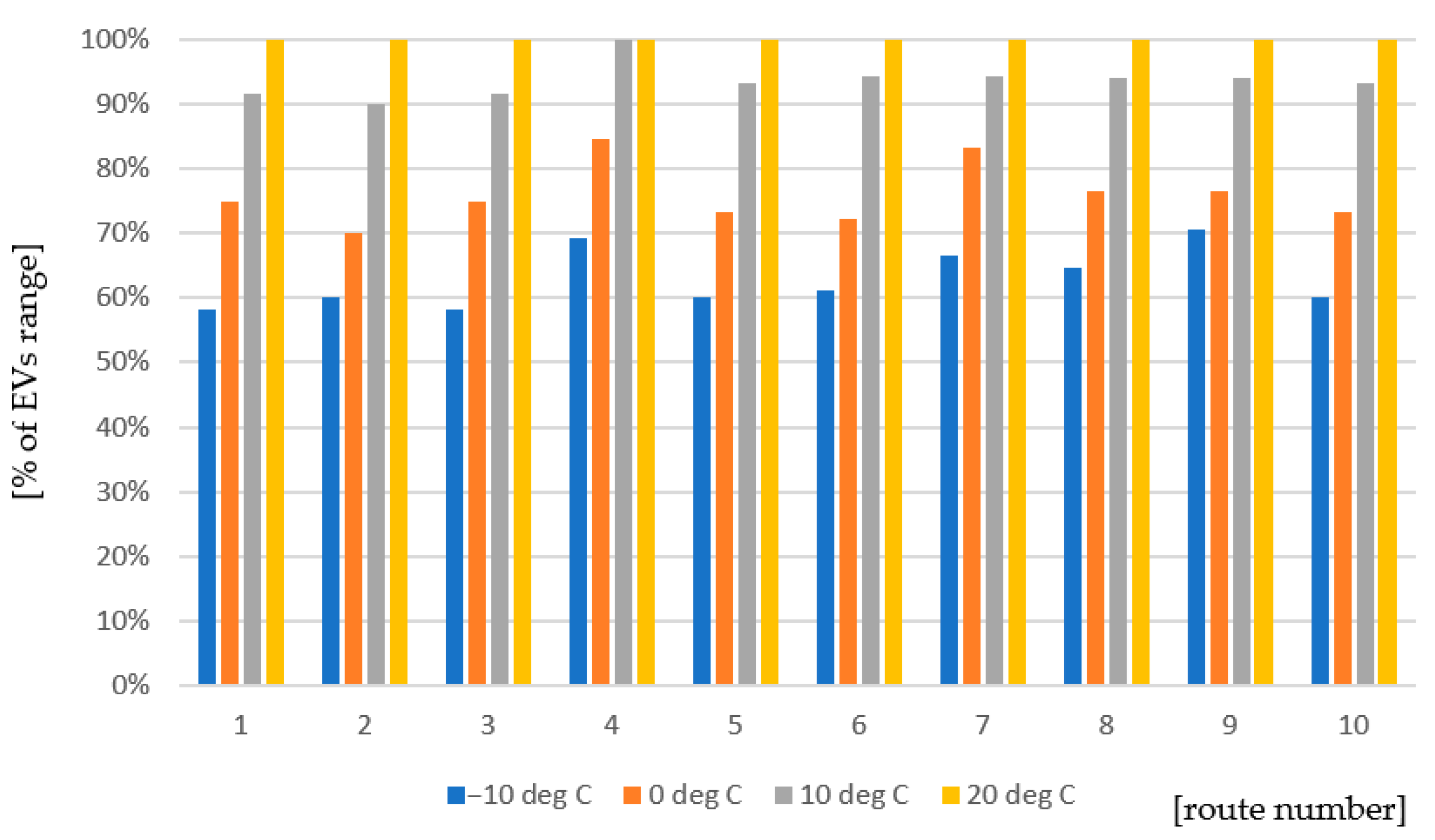
| Route Number | Route Completion Time [h] | Route Length [km] | Number of Collection Points | Collected Waste Weight [t] |
|---|---|---|---|---|
| 1 | 07:42:51 | 254 | 17 | 1.78 |
| 2 | 09:16:59 | 285 | 15 | 1.65 |
| 3 | 09:15:14 | 222 | 16 | 1.32 |
| 4 | 06:30:40 | 179 | 14 | 1.55 |
| 5 | 07:10:10 | 195 | 16 | 1.70 |
| 6 | 06:40:00 | 181 | 19 | 1.74 |
| 7 | 07:40:40 | 176 | 19 | 1.82 |
| 8 | 06:30:00 | 171 | 18 | 1.65 |
| 9 | 07:40:00 | 183 | 19 | 1.78 |
| 10 | 06:35:00 | 186 | 16 | 1.65 |
| Mean [-] | 07:37:46 | 212 | 17 | 2.00 |
| σ | √(01:32:26) | √102.69 | √2.19 | √0.22 |
| Route Number | Number of Collection Points at −10 °C | EV Range at −10 °C [km] | Number of Collection Points at 0 °C | EV Range at 0 °C [km] | Number of Collection Points at +10 °C | EV Range at +10 °C [km] | Number of Collection Points at +20 °C |
|---|---|---|---|---|---|---|---|
| 1 | 7 | 88 | 9 | 113 | 11 | 138 | 12 |
| 2 | 6 | 90 | 7 | 105 | 9 | 135 | 10 |
| 3 | 7 | 88 | 9 | 113 | 11 | 138 | 12 |
| 4 | 9 | 104 | 11 | 127 | 13 | 150 | 13 |
| 5 | 9 | 90 | 11 | 110 | 14 | 140 | 15 |
| 6 | 11 | 92 | 13 | 108 | 17 | 142 | 18 |
| 7 | 12 | 100 | 15 | 125 | 17 | 142 | 18 |
| 8 | 11 | 97 | 13 | 115 | 16 | 141 | 17 |
| 9 | 12 | 106 | 13 | 115 | 16 | 141 | 17 |
| 10 | 9 | 90 | 11 | 110 | 14 | 140 | 15 |
Disclaimer/Publisher’s Note: The statements, opinions and data contained in all publications are solely those of the individual author(s) and contributor(s) and not of MDPI and/or the editor(s). MDPI and/or the editor(s) disclaim responsibility for any injury to people or property resulting from any ideas, methods, instructions or products referred to in the content. |
© 2024 by the authors. Licensee MDPI, Basel, Switzerland. This article is an open access article distributed under the terms and conditions of the Creative Commons Attribution (CC BY) license (https://creativecommons.org/licenses/by/4.0/).
Share and Cite
Cieśla, M.; Nowakowski, P.; Wala, M. The Impact of Variable Ambient Temperatures on the Energy Efficiency and Performance of Electric Vehicles during Waste Collection. Energies 2024, 17, 4228. https://doi.org/10.3390/en17174228
Cieśla M, Nowakowski P, Wala M. The Impact of Variable Ambient Temperatures on the Energy Efficiency and Performance of Electric Vehicles during Waste Collection. Energies. 2024; 17(17):4228. https://doi.org/10.3390/en17174228
Chicago/Turabian StyleCieśla, Maria, Piotr Nowakowski, and Mariusz Wala. 2024. "The Impact of Variable Ambient Temperatures on the Energy Efficiency and Performance of Electric Vehicles during Waste Collection" Energies 17, no. 17: 4228. https://doi.org/10.3390/en17174228
APA StyleCieśla, M., Nowakowski, P., & Wala, M. (2024). The Impact of Variable Ambient Temperatures on the Energy Efficiency and Performance of Electric Vehicles during Waste Collection. Energies, 17(17), 4228. https://doi.org/10.3390/en17174228








